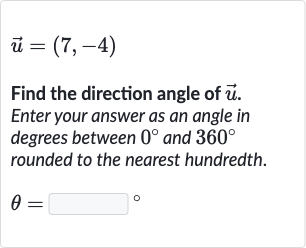Full solution
Q. Find the direction angle of . Enter your answer as an angle in degrees between and rounded to the nearest hundredth.
- Calculate ratio of coordinates: To find the direction angle of the vector , we need to calculate the angle that this vector makes with the positive x-axis. The direction angle, often denoted as , can be found using the arctangent function (also known as the inverse tangent or ), which gives us the angle whose tangent is the ratio of the y-coordinate to the x-coordinate of the vector.
- Use arctangent function: First, we calculate the ratio of the y-coordinate to the x-coordinate of the vector . This ratio is . We will use this ratio to find the angle with the arctangent function.
- Adjust angle for quadrant: Next, we use the arctangent function to find the angle . We have to be careful because the arctangent function will give us an angle in the range of to , but we want the angle in the range of to . Since the x-coordinate is positive and the y-coordinate is negative, the vector is in the fourth quadrant.
- Calculate direction angle: Using a calculator, we find that . However, this is the angle measured counterclockwise from the positive x-axis to the vector, and since it's negative, it's actually measured clockwise. To find the direction angle in the range of to , we add to this angle.
- Add for range adjustment: Performing the calculation gives us the direction angle of the vector in the correct range:
More problems from Inverses of sin, cos, and tan: degrees
QuestionGet tutor help
QuestionGet tutor help
QuestionGet tutor help
QuestionGet tutor help
QuestionGet tutor help
QuestionGet tutor help
Question
. Find the value of in degrees.Write your answer in simplified, rationalized form. Do not round.____
Get tutor helpQuestionGet tutor help

